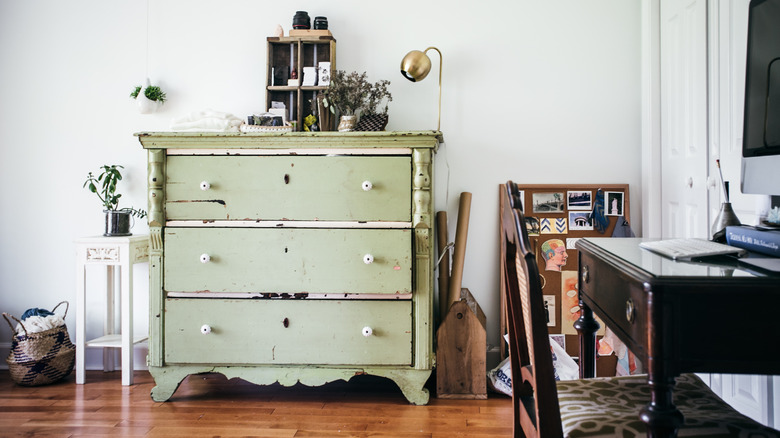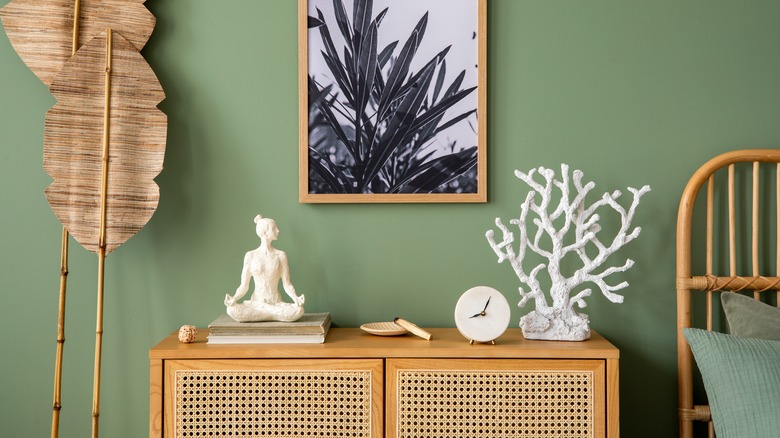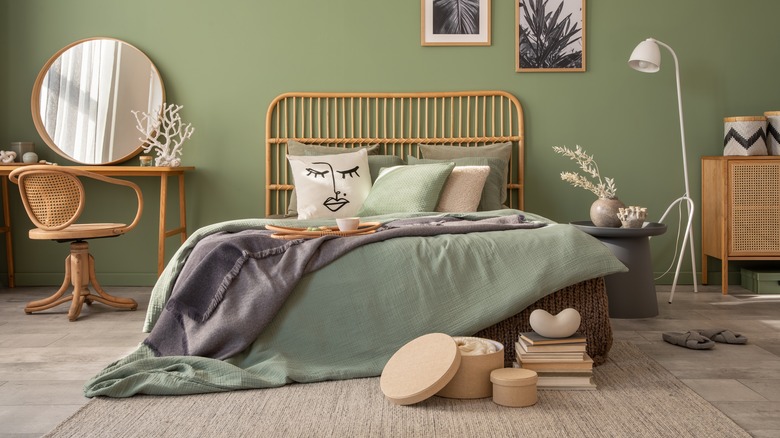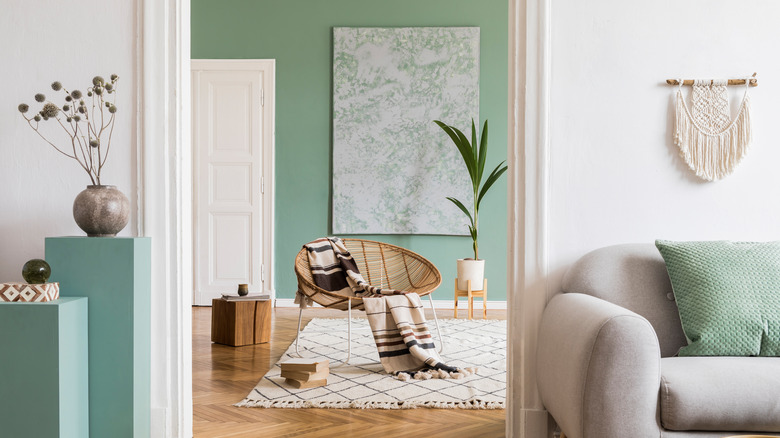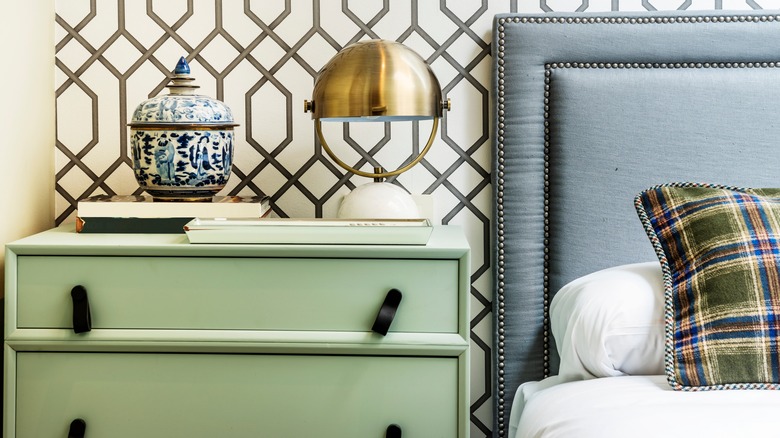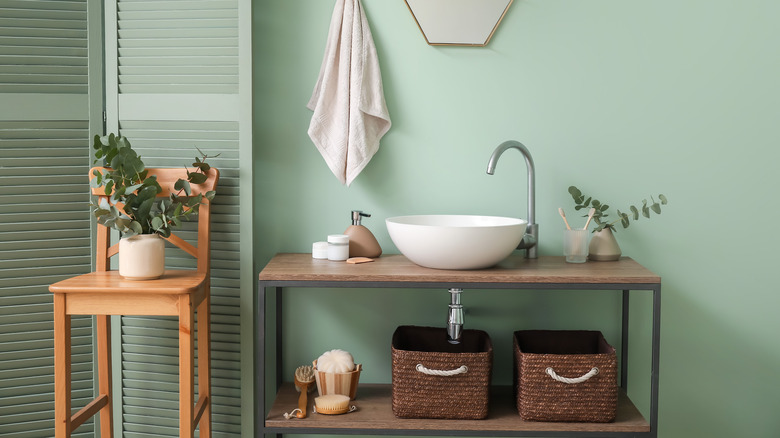5 Tips For Decorating Your Home With Soft Sage Green
Soft sage green is one of the colors most often found in the natural world. It's a color that exudes serenity and earthiness and can often be found in any outdoor space in abundance. Inside, it's a natural choice for everything from wall colors to soft elements and upholstery, bringing a bit of the outside into interior spaces. Soft sage can be found in a number of color intensities, from a more solid shade of light green to an ethereal, barely-there pale green cast. According to Canva, it is a color that not only evokes nature and ecology but also wisdom.
Soft sage usually involves a mix of green and gray, making it a popular muted color perfect for any room in large or small doses. It can also be used as a neutral in some instances alongside its close cousins, grey and khaki, in which it is often found in proximity. Whatever your current or desired color scheme, there are a number of ways you can take advantage of the beauty of this rich, nature-inspired shade in your home.
1. Inspired by nature
A soft sage green seems perfectly plucked from nature, where you see it everywhere, from plant stems to the soft underside of leaves. The color, therefore, makes a perfect backdrop for other natural materials like wood and bamboo, as well as stone, coral, and other assorted greenery. According to Woman & Home, the shade is an excellent way of connecting you and your decor to the natural environment.
Consider a soft sage green wall as a backdrop to an Eastern-inspired oasis in the bedroom or bathroom, incorporating natural elements like bamboo-fronted cabinets and headboards. Try sage green bedding in a bedroom filled with natural elements like sisal rugs and bamboo dressing screens. Other nature-inspired colors like khaki, cream, and brown make excellent accent colors in a sage green room and form a harmonious balance with the shade. A nature-inspired room with soft sage green at its center immediately brings calmness and a sense of zen to any home. If you're looking to add some color variation, try floral-driven accent colors like pale pink and coral.
2. Layering shades of green
One of the softest, lightest shades of green, sage is perfect when layered with other shades of the same color. It's a perfect addition alongside deeper, darker moss and forest greens, as well as other shades like olive, basil, and juniper. Look for other shades of green that have a grayish or brownish cast. Monochrome color schemes and layering often bring attention to the color in ways that small doses do not, so go wild with it. According to Sarah Montgomery Designs, layering shades of green is one of the hottest trends in recent years.
Consider bedding in a variety of shades of deeper to lighter green with gray accents. Or a bathroom design incorporating other shades of pale green like celadon and pistachio. Because they mimic what we find in nature, many varieties of green go well with sage; you have only to look outside your window for inspiration. Deep forest and moss greens with a gray base are perfect for layering with pale, barely-there shades of softest sage.
3. Sage green amidst neutrals
A shot of soft sage green amongst an otherwise neutral color palate is the perfect way to incorporate some fresh, dynamic color amongst grays, beiges, creams, and browns. Soft sage green is a color that many, according to LiLu Interiors, consider another neutral for its easy ability to be integrated into most decor schemes. The shade also boasts a friendliness to many other accent colors, including orange, pink, and blue.
If you are looking for a low commitment, soft way to add some color to a neutral room, sage green offers a fresh, nature-inspired boost without drawing too much attention to itself. Consider it for throw pillows and accent lamps, as well as blankets, vases, and window treatments. In a neutral room, sage green can be paired perfectly with a dusty rose or peach shade for warmth or a pale, barely-there aqua or blue for sea-washed elegance. Sage green looks especially lovely with gray interiors.
4. Sage green finishes
Because it is often considered a neutral shade by designers, soft sage green also works well on painted furniture pieces. Whether you have a colorful room or a neutral one, a sage green piece of furniture is a great contrast color for pinks, turquoise, and purples, as well as a pop of color for neutral decor schemes that avoids being too bright or ostentatious, even in the slightly deeper shade ranges. According to A Ray of Sunlight, the shade compliments mid-century pieces as much as it does older eras of design.
Consider a set of sage green end tables or nightstands for your bedroom. Sage green also works perfectly as a shade for bookshelves, offering a bit of color but remaining a neutral or complimentary backdrop for multi-colored book spines. Cottage-style, modern farmhouse, and shabby chic decor work perfectly with weathered, painted pieces in soft sage green. A sage green headboard or bed frame pairs perfectly with a number of colors of bedding, including layered shades of green, grey, pink, and lilac.
5. A bathroom oasis
If you are looking for the perfect space in your home to bring in sage green, you might consider your bathroom first. According to Garland Designs, sage green offers bathrooms, in particular, an excellent natural spa-like feel. Here, it can be paired with natural elements like bamboo, baskets, stone, tile, and other materials that speak to the most luxurious spas. Green is also a calming color to start your day with but gives off great natural energy that immediately infuses even the dimmest mornings.
Other colors in your bathroom that may compliment sage green include cream, tan, khaki, and grey. Layer shades of green in your bathroom for a rich, nature-inspired look. Incorporate ample plants that will love you for their proximity to your steamy shower, as well as thick cotton towels in neutral shades. Consider a grass cloth accent wall in your sage green bathroom to offer a bit of texture and depth to your decor.
